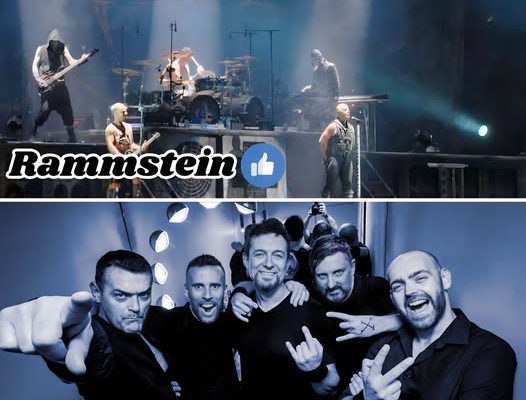GRAND SOUND CLASH: Rammstein’s monumental industrial metal collides with Pitchshifter’s daring blend of electronic energy, nu-metal edge, and experimental intensity.
When two sonic titans like Rammstein and Pitchshifter are mentioned in the same breath, one can only expect an earth-shaking clash of sound, style, and raw creativity. Both bands, though emerging from different cultural backdrops and musical philosophies, share a common passion — breaking boundaries, redefining genres, and creating music that challenges both the ear and the mind. This grand sound clash is not merely a collision of noise, but a fusion of art, emotion, and rebellion. It’s the meeting of Rammstein’s towering industrial metal power with Pitchshifter’s daring mix of electronic beats, nu-metal aggression, and experimental brilliance — a storm that promises to captivate every lover of heavy, thought-provoking music.
Rammstein, hailing from Germany, has long been synonymous with industrial metal at its most powerful and theatrical. Since the mid-1990s, they have dominated stages around the world with their dark, fiery performances and uncompromising sound. Every chord, every lyric, and every burst of flame feels like a carefully crafted work of art. Their music carries the weight of German precision and emotional intensity — a combination that has made them one of the most influential bands of their generation. Their songs like Du Hast, Ich Will, and Sonne have become anthems that transcend language, blending heavy guitar riffs with haunting synth layers and deep, commanding vocals from Till Lindemann. Their artistry is built not only on sound but on experience — a complete sensory assault where fire, rhythm, and emotion intertwine.
On the other side of the sonic battlefield stands Pitchshifter, the British band known for tearing apart musical conventions and building something entirely new from the wreckage. Emerging from the underground industrial scene, Pitchshifter evolved into one of the most innovative bands of the late 1990s and early 2000s, weaving together elements of electronic music, drum and bass, punk energy, and metal grit. Their ability to mix distorted guitars with pounding beats and digital textures created a sound that was futuristic yet deeply human — a rebellion against musical conformity. Songs like Genius, Microwaved, and Please Sir captured the spirit of experimentation and defiance. Their music, much like Rammstein’s, is political, confrontational, and unapologetically loud. But while Rammstein draws from industrial precision and German expressionism, Pitchshifter thrives in chaos, embracing technology, distortion, and raw emotion as instruments of protest.
To imagine these two forces meeting in a grand sound clash is to picture a world where order meets chaos, where steel meets circuitry, and where two decades of industrial evolution fuse into one thunderous experience. The result is not a competition but a collaboration of extremes — a musical dialogue between Rammstein’s fire-forged discipline and Pitchshifter’s electronic rebellion. It’s an exploration of how industrial metal can stretch beyond its limits, integrating electronic rhythms, digital manipulation, and hybrid energy into something both brutal and beautiful.
In such a setting, one could imagine Rammstein’s relentless rhythm section pounding like a machine while Pitchshifter’s digital textures weave through the cracks, creating a landscape of sound that feels both futuristic and primal. The combination of Till Lindemann’s deep, theatrical vocals with Pitchshifter’s gritty, distorted effects could produce a sound that is darkly hypnotic — a soundtrack to modern chaos. Both bands have always been storytellers in their own right, using sound as a language to critique society, explore identity, and confront the struggles of modern existence. Together, their message becomes louder, sharper, and more unified.
The beauty of this imagined collaboration lies in how both bands represent evolution within heavy music. Rammstein refined industrial metal into an art form that could fill stadiums, while Pitchshifter deconstructed the genre, blending it with technology and social commentary. Rammstein’s power lies in their discipline — every performance is a calculated explosion of energy. Pitchshifter, however, thrives in unpredictability — their sound constantly shifting, morphing, and mutating. Together, they would create a sonic ecosystem that reflects both order and rebellion, control and chaos, machinery and emotion. It would be a perfect metaphor for the modern world — a space where humanity struggles to find meaning within technology, and art becomes the bridge between them.
Fans of both bands would experience something extraordinary — a fusion that transcends genre boundaries and cultural barriers. The industrial pulses of Rammstein’s sound, amplified by Pitchshifter’s futuristic electronics, would give rise to new textures, rhythms, and sensations. Each song could feel like a confrontation between the past and the future, with metal riffs colliding against electronic walls and digital echoes responding to human screams. The result would not be pure aggression, but a form of emotional catharsis — music that speaks to the tension of living in an age dominated by machines, media, and change.
Moreover, both bands share a theatrical approach to performance. Rammstein’s use of pyrotechnics, lighting, and stage design creates an atmosphere that feels like a living, breathing organism. Pitchshifter’s experimental visuals and energetic presence add a raw edge to this aesthetic. Together, their live collaboration would be nothing short of cinematic — an immersive experience that goes beyond listening to become something you feel. The stage could transform into a futuristic battleground of sound and light, where each song tells a story of power, rebellion, and transformation.
Beyond the spectacle, this clash of sound also represents a philosophical meeting. Rammstein explores the human condition through dark poetry and symbolism, often challenging norms and taboos. Pitchshifter, meanwhile, channels frustration and social critique through satire and distortion. Both approach their art as a mirror to society, forcing audiences to confront the realities of control, freedom, and individuality. Their combined vision could give voice to a generation seeking authenticity in a digital world, expressing both the beauty and brutality of human experience.
As the echoes of this imagined collaboration fade, what remains is a sense of awe — a reminder of how powerful music can be when it refuses to be confined. The grand sound clash between Rammstein and Pitchshifter is more than just a fantasy of noise and fury; it’s a celebration of innovation, courage, and passion. It shows that music, at its core, is about evolution — about taking risks, blending influences, and creating something entirely new from the fragments of what came before.
In this convergence of metal and machine, we find the perfect metaphor for our times: a world where technology and humanity are forever intertwined, where emotion is expressed through electricity, and where rebellion still burns through the circuits of sound. Whether imagined or realized, this grand clash would remind us that music’s greatest power lies in its ability to transform — to ignite emotion, challenge perception, and connect souls through the universal language of sound.



